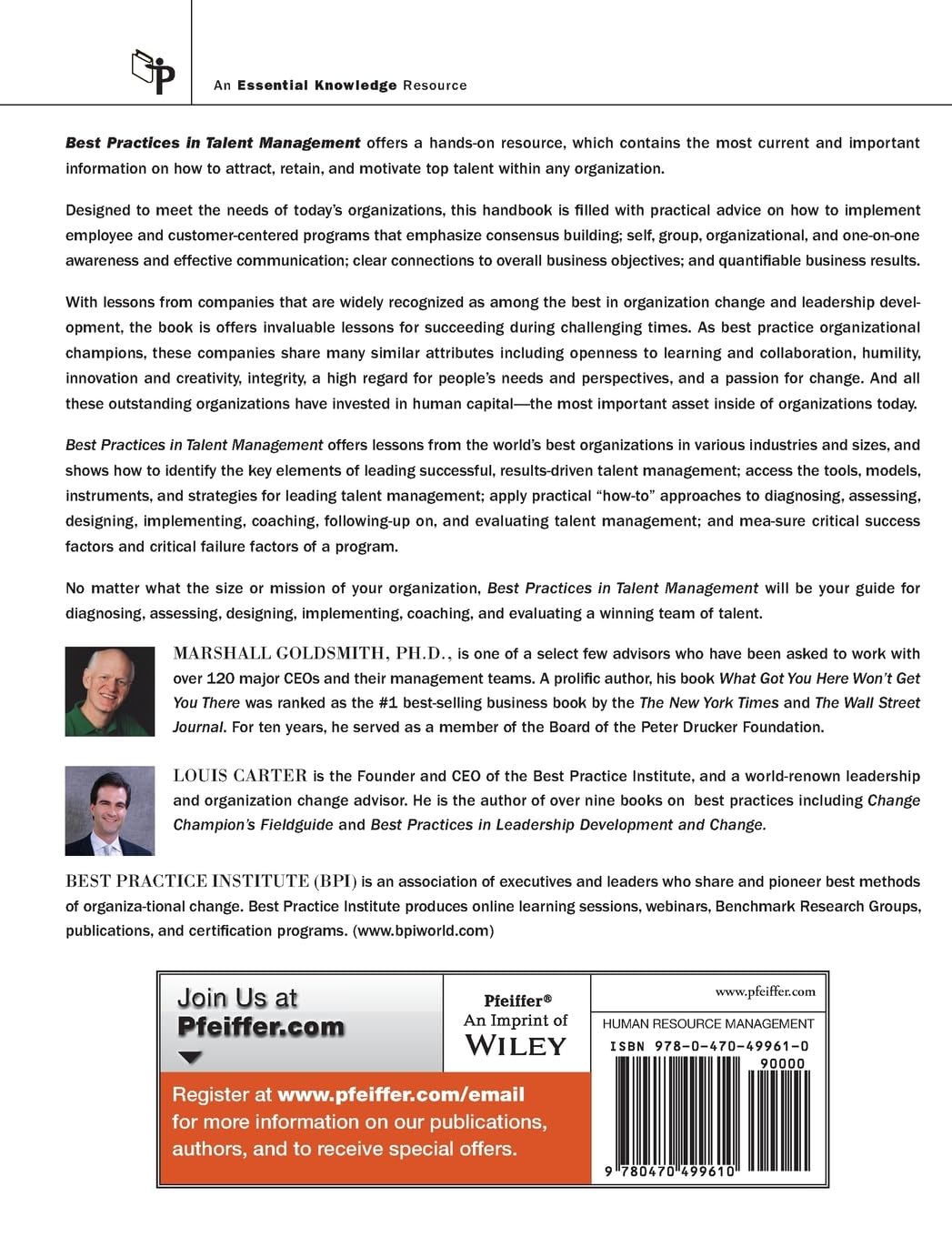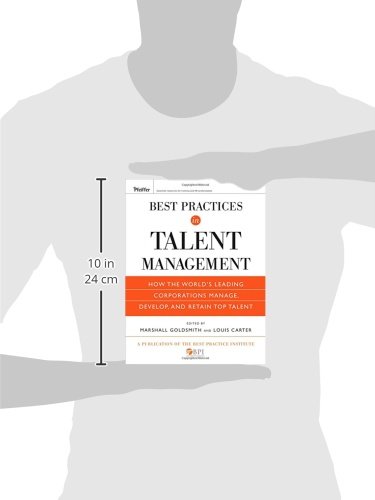Customer Services
Copyright © 2025 Desertcart Holdings Limited
Desert Online General Trading LLC
Dubai, United Arab Emirates




Full description not available
W**A
Talent management strategies and techniques to succeed in HR
This book is among the best in talent management strategies utilized by organizations to develop, deploy, and retain talent.
V**A
Five Stars
I would defenitly recmmand this book to any HRM student
D**R
A great read
This book is a great read and very informational. Lots of information on the Resource development plans of different companies.
R**S
Ultimately, the effectiveness of best practices depends on those who execute them
As co-editors Marshall Goldsmith and Louis Carter explain, the material in this book focuses on 14 dynamic enterprises (i.e. Avon Products, Bank of America, Corning, CES, Ecolab, GE, IRS, Kaiser Permanente/Colorado Region, McDonald's, Microsoft, Murray & Roberts, Porter Novelli, Southern Company, and Whirlpool) that were selected by the Best Practice Institute because they have succeeded in implementing talent enhancement programs - "although, to be fair, to call them `programs' is not entirely accurate, as they are in reality vital strategic components integrated into the companies' core operating values." Indeed, had they not been so integrated, neither they nor their companies could become, much less remain, vital and dynamic. There is a separate chapter devoted to each of the 14, written by one or more of the contributors who were invited to participate. It is important to keep in mind that in an age when several companies "built to last" haven't and others once great are no longer even good, at least a few of the 14 in this book may no long be exemplars of anything, except perhaps of how quickly an organization can become weakened in one way or another.I appreciate the material provided in the Conclusion introduced by this explanation: "In order t0 present a fuller and more complete picture of the best practices in talent management, in March 2009 the Best Practice Institute [of which Cater is founder and CEO] released results from a groundbreaking survey of some of America's most dynamic companies." An overview is provided in the Conclusion. Then in the Epilogue, William J. Rothwell suggests several "key take-away points" from each of the 14 mini-case studies. From Ecolab, for example, "This case is outstanding for illustrating how a talent program can be built on, and leverage, the organization's culture and values. These values include, according to the case, (1) spirit; (2) pride; (3) determination; (4) commitment; (5) passion; and (6) integrity. The talent program was based on internal interviews of company executives." Obviously, brief take-away points merely serve as triggers to recall insights that are developed in much greater depth, in context.Presumably Goldsmith and Carter are responsible for the reader-friendly format that most of the contributors adopt (with only minor modification) and graphic devices such as Figures that consolidate a wealth of information about an especially important subject such as Avon's "Talent Investment Matrix" (Page 6), Corning's "Program Snapshot - Week One" (50), Ecolab's "Success Indicators for Business Drivers at Each Pipeline Level" (90), "IRS Leadership Core Responsibilities" (119), McDonald's "Performance Drivers" (162), and Microsoft's "Key Stakeholder Roles for HiPo Coaching program" (196). Because they are best practices, these and others examined in the book should serve as exempla that suggest possibilities rather than as templates to be adopted without revision or modification. That is to say, doing what is right and doing it right pose entirely different challenges.Those who share my high regard for the material in this volume are urged to check out George Anders' recently published book, The Rare Find: Spotting Exceptional Talent Before Everyone Else, as well as Dean Spitzer's Transforming Performance Measurement: Rethinking the Way We Measure and Drive Organizational Success, and Enterprise Architecture As Strategy: Creating a Foundation for Business Execution co-authored by Jeanne W. Ross, Peter Weill, and, David C. Robertson.
J**N
Incredible collection of talent management techniques and best practices
This book is an incredible resource for anyone dedicated to attracting, retaining and motivating top talent within their business. Each chapter serves as its own white paper of best practices regarding talent management within some of America's most powerful and intriguing organizations. Each case study supplies a surprisingly granular review of the best practices utilized by experts and organizations throughout a variety of industries. On top of it all, each chapter is written by the practitioners who not only utilize these methods but many times developed and implemented them as well. I found the format to be well thought out, the professionals incorporated to be superlative, and the content to be outstanding. If you are looking for an eclectic industry review of the best practices regarding talent management then look no further.
R**R
Not just another leadership book....Excellent!
If you want information from actual Fortune 500 companies on what they do to manage and develop talent - then this is the book to read. It is a first-rate reference and research book. It would take years to compile this kind of information from the 14 companies in this book. You will learn about the work of CEO Andrea Jung's Talent Management Group at Avon, the executive development strategy and executive on-boarding program at Bank of America, Corning's boot camp immersion experience for potential program managers, Ecolab's Talent Council, GE's lean approach to staffing, and many other invaluable talent practices from companies like Whirlpool, McDonalds, Microsoft, Southern Company and more. This book is full of invaluable information you could not get elsewhere.And..in addition, Lou Carter, CEO, Best Practice Institute can write this book because he embodies excellent leadership abilities and conducts very informative webinars.Rosalie Lober, Ph.D.CEO PROFITS Principles, [...]Author of:Run Your Business Like A Fortune 100: 7 Principles For Boosting PROFITS(John Wiley & Sons, June 2009)and forthcoming:Deliverance: From the Valley of Death to Sustainable PROFITS
G**S
A surprisingly unique perspective
Lou's surprisingly unique perspective is evident throughout Talent Management. Through The Best Practices Institute he has created a one of a kind lightning rod for what works in corporate talent management. The book's cases are viewed through Lou's powerful lens - one that has been polished by extensive research, interviews and countless webinars with hundreds of thought leaders. Lou's knowledge platform provides the reader with a select vantage point to clearly see lessons from carefully chosen examples. Each case demonstrates end-to-end initiatives and interventions in an accessible manner making it possible for readers to replicate in most any organizational setting.Gordon CurtisCurtis ConsultingCoach, Agent, AuthorWell Connected, Wiley/Jossey-Bass, July, 2010
Trustpilot
5 days ago
1 week ago
2 weeks ago
1 month ago